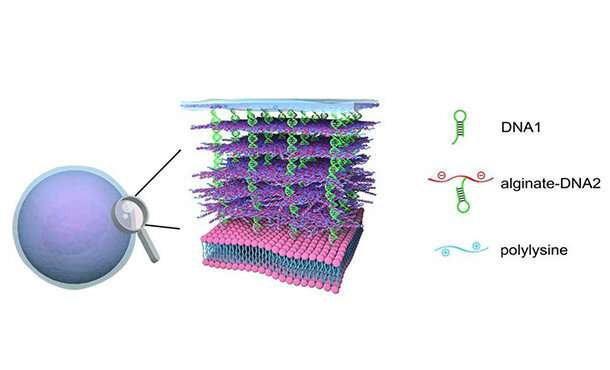Bioengineered cell walls open new medical, research possibilities

Biomedical engineers at Penn State have developed a process to build protective, synthetic plant cell walls around animal cells. The work, published in Nature Communications, could hold significant potential for a variety of medical and biomanufacturing applications for human health.
Plant cells are individually encased in ultrathin cell walls that maintain the cell's structure and protect the cell's inner organelles from environmental assaults such as heat and shear stress. Human and other mammalian cells don't have this exterior wall, leaving them vulnerable to damage or destruction. By creating a cell wall made of biomimetic materials—synthetic materials that mimic biology—researchers can protect human cells for use in vitro cell therapy to treat disease and in bioprinting.
While some techniques, such as hydrogel encapsulation, currently exist to help protect mammalian cells in the laboratory setting, they are thick and limit nutrient and oxygen access, limiting cell survival. According to Yong Wang, professor of biomedical engineering and principal investigator on the study, this problem of how to better protect cells has been studied for half a century. While many researchers have tried various methods, Wang's approach is novel.
"No one has ever built up a nanoscale material that can really mimic the structure and functions of plant cell walls; our concept is completely new," Wang said.
Called biomimetic cell walls (BCWs), this nanoscale material mimics the structural strength and functions of plant cell walls. Wang compared the process of creating BCWs to building a house. A foundation is laid before the framework can be erected. Once the framework is up, the floors and ceilings must be finished.
"Similarly, we synthesize BCWs with a framing template and, based on the framing template, we build up a crosslinked matrix," Wang said. "The framing templates are like wooden beams, and the crosslinked matrices are like drywall."
The framing template is actually a supramolecular DNA structure, made up of DNA building blocks spliced with natural polysaccharides. This guides the formation of the crosslinked matrix, made of bonded sugar molecules and linked amino acids. This crosslinked matrix forms on top of the framing template to create the cell wall.
Wang said the study revealed how nucleic acids, the complex organic polymers that make up the genetic material of all cells, can be used as a structural template to guide nanoscale assembly for a variety of molecules. Critically, the guide also allows the non-nucleic acid materials to attach to the cell surface, enabling the BCWs to encase the cells.
"Most importantly, this process does not involve any complicated equipment. But it enables mammalian cells to be protected in vitro and in vivo," Wang said. "The BCWs basically become part of the cell."
Once the cells are encased in BCWs, the researchers demonstrated that the cells are protected not only from physical assaults, but also from biological attacks such as immune system rejection.
"When you implant the cells into a host, the patient's immune system will fight against the transplanted cells and kill them," Wang said. "If we have this bioengineered cell wall on the cell surface to protect cells from biological assaults, they can survive long enough for effective cell-therapy treatments for diseases such as cardiac disorders and diabetes."
Cell therapy involves transplanting human cells to help repair or completely replace damaged tissues. According to Wang, the use of BCWs could drastically improve treatments available to patients with diseases such as diabetes.
"Transplanting insulin-releasing beta cells into patents would be a more effective diabetes treatment than insulin injections, because the cells actually sense blood sugar levels and produce insulin to reduce them," Wang said. "However, without cell walls, the patient's immune system will kill the cells within a week. But we have found that BCWs hold great potential to protect them."
Wang also noted that BCWs could have a significant impact on biomanufacturing, especially 3-D bioprinting. Used to build tissue, bone, blood vessels and, potentially, even organs, the bioprinting ink consists of living cells.
"During bioprinting, cells can be burned, and the cell membrane can be damaged," Wang said. "If you can add a cell wall on the surface, then the cell will be protected during bioprinting."
Wang said his team's next steps are to optimize and customize BCWs to the various applications. For example, Wang said that while their current version of BCWs would be enough protection for cardiac cell therapy, diabetes cell therapy requires a strong BCW structure due to the strength of immune system attacks on beta cells.
"If you are working with mammalian cells and you need to protect the cells, this method will help," Wang said. "There are just so many potential applications, it's up to the researcher's imagination when tuning the properties of BCW for a specific application."
More information: Peng Shi et al. DNA-templated synthesis of biomimetic cell wall for nanoencapsulation and protection of mammalian cells, Nature Communications (2019). DOI: 10.1038/s41467-019-10231-y
Journal information: Nature Communications
Provided by Pennsylvania State University




















